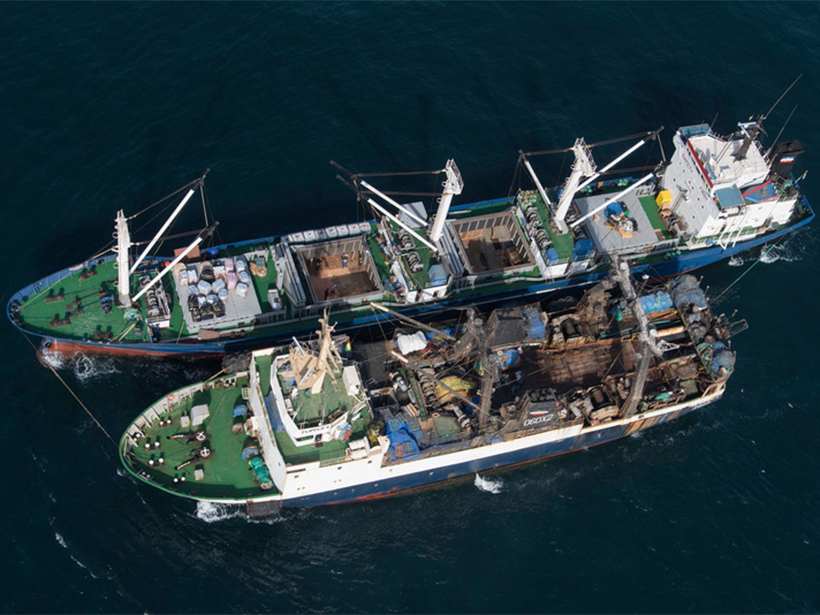Fishing is an enormous industry—topping $100 billion per year—but waters often turn murky when it comes to determining where exactly fish are caught. That’s because illegal catches are frequently moved at sea from fishing boats onto cargo vessels, a transfer known as a “transshipment” that can mask the dubious provenance of seafood.
Now, researchers have pinpointed more than 10,000 likely transshipments by mining billions of recorded ship positions recorded over 6 years. The analysis reveals transshipment “hot spots” near Russia and West Africa, results that can help maritime officials target patrol efforts, the scientists suggest.
Money Laundering at Sea
“The transshipment of fish catch at sea plays a big role in the seafood supply chain.”
Offloading seafood onto refrigerated cargo ships at sea allows fishing vessels to remain in prime fishing areas, which saves time and fuel. “The transshipment of fish catch at sea plays a big role in the seafood supply chain,” said Kristina Börder, a biologist at Dalhousie University in Nova Scotia, Canada, and the leader of the new study, which was published last month in Science Advances.
But the practice of transshipment can also function like money laundering by hiding the true origin of potentially illegal catches, said Börder. Research has shown that more than 25% of wild-caught seafood in major markets is caught illegally, in violation of laws regarding fish caught in protected areas, catches obtained without a license, and the use of prohibited fishing gear.
To identify these aquatic rendezvous, Börder and her collaborators analyzed more than 22 billion position signals from ships. The data, collected via satellites between 2012 and 2017, are part of the Automatic Identification System required by the International Maritime Organization on all ships larger than 300 metric tons engaging in international voyages.
Ships’ position signals do more than just pinpoint the presence of a ship at a specific location: They also record each ship’s speed, course, and type (fishing vessel, cargo vessel, etc.). A ship’s information is collected every few seconds, and vessel positions are determined to within about 10 meters. It’s the maritime equivalent of air traffic control.
Börder and her colleagues looked for likely transshipments by flagging close, prolonged encounters between a fishing vessel and a refrigerated cargo vessel. They found 10,510 such events, 65% of which took place within the exclusive economic zones near coastlines where most fishing occurs. By coupling known information on the fishing vessels’ gear type with the tracked locations, the scientists inferred that tuna, swordfish, and marlin were among the most commonly transshipped species.
Hot Spots and Flags of Convenience
Vessels registered under so-called flags of convenience tended to be overrepresented in transshipment.
The researchers found intriguing patterns in their data. Likely transshipments tended to cluster geographically, with the highest concentrations in waters near Russia and West Africa, Börder and her colleagues reported. The scientists also showed that ships registered in Russia, China, and Taiwan engaged in the most transshipments. Finding China on that list wasn’t a surprise, Börder remarked. “China is responsible for 40% of the international fishing effort,” she said. “That’s more than the next 10 countries combined.”
Börder and her collaborators also noted that vessels registered under so-called flags of convenience tended to be overrepresented in transshipment. Several countries, like Panama and Liberia, are known for loose maritime regulations. Ship owners who choose to register their vessels in such countries can be assured that oversight of their fleets will be limited. More than 40% of cargo vessels engaged in transshipments were represented by flags of convenience.
This study provides a “very good visual snapshot of hotspots,” said Pramŏd Ganapathiraju, a fisheries compliance and illegal fishing consultant at IUU Risk Intelligence in Vancouver, British Columbia, who was not involved in the research. It’s a neat demonstration of using abundant satellite data to track transshipments rather than relying on having maritime officials on board ships, he added.
More Than Just Fishing
“Workers are on vessels for years and years on end, often in questionable circumstances.”
The researchers note that their work is more than simply identifying where seafood is being transferred. Transshipments not only allow fishing vessels to offload their catch, but they also provide fishing vessels with supplies such as food and fuel. The latter transfers mean that fishing boats can remain at sea for long periods of time.
“Workers are on vessels for years and years on end, often in questionable circumstances,” said Börder. For example, the Associated Press has reported that wages on board ships can be deplorably low or nonexistent—in essence, slavery. The United Nations has also found evidence that workers can be forced to engage in weapons or drug trafficking.
In fact, in response to the recent research, Börder’s team was contacted by an organization in Thailand that focuses on links between transshipments and human rights abuses.
“This goes beyond the fish,” she said.
—Katherine Kornei (email: [email protected]; @katherinekornei), Freelance Science Journalist
Citation:
Kornei, K. (2018), Illegal seafood supply chains can now be tracked by satellite, Eos, 99, https://doi.org/10.1029/2018EO104931. Published on 24 August 2018.
Text © 2018. The authors. CC BY-NC-ND 3.0
Except where otherwise noted, images are subject to copyright. Any reuse without express permission from the copyright owner is prohibited.

